Striving to be at the cutting edge of one's art – Artist Kuo Chang-si/淬鍊成鋒 工藝大師郭常喜
Striving to be at the cutting edge of one's art - Artist Kuo Chang-si
◎English translation: Marie-claude Pelchat
◎Photos by Pao Chung-hui
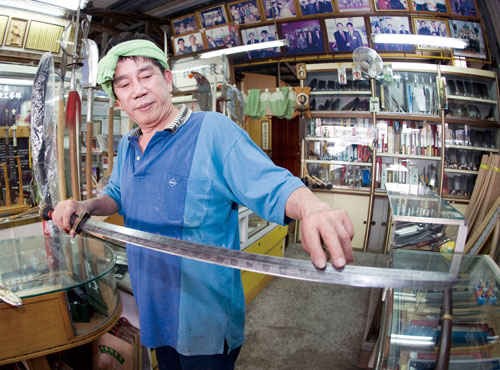 The Singda Port area, a landscape dotted with fishing villages, is where renowned local artist Kuo Chang-si established his Singda Arts Sword Store. In the dark forge, next to the furnace where temperatures reach 1,300 to 2,000 degrees Celsius, stands the silent figure of the smith, wielding a pair of tongs in the fire, sparks flying around. The flames not only illuminate the face of Kuo Chang-si, but are also a testimony to the 50 years he has devoted to refining the art of sword-making, constantly endeavoring to outdo himself.
The Singda Port area, a landscape dotted with fishing villages, is where renowned local artist Kuo Chang-si established his Singda Arts Sword Store. In the dark forge, next to the furnace where temperatures reach 1,300 to 2,000 degrees Celsius, stands the silent figure of the smith, wielding a pair of tongs in the fire, sparks flying around. The flames not only illuminate the face of Kuo Chang-si, but are also a testimony to the 50 years he has devoted to refining the art of sword-making, constantly endeavoring to outdo himself.
Kuo began learning blacksmith techniques from his father when he was 13 years old. He explains that blacksmithery earns little profit, and although he once tried to switch trades, in the end he came back to the work he knows best. He started out making everyday items like knives and pickaxes, but over the course of 30 years he parlayed his experience and enthusiasm for forging metal into developing production techniques for swords. Kuo progressively developed a multiple-layered veined steel manufacturing process which he has patented. He combines Damascus steel techniques from India, Japanese sword-making techniques as well as ancient steel-wrapping techniques (the inside is iron while the outside is wrapped with steel) to preserve ancient sword-making techniques. His swords are not only extremely strong, but also have artistic value. Many collectors have ordered swords from Kuo, but he says that he still produces kitchen knives to give his customers a choice.
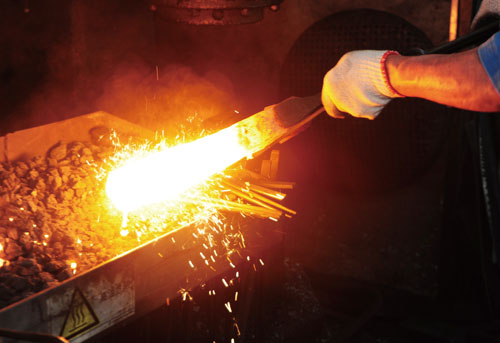 Kuo says: "A sword is a work of art, so production is not limited by time." Swords made of steel usually display distinctive patterns that form naturally during the production process. However, the formation of such patterns can actually be controlled by multiple-layered steel techniques, and this is Kuo's major innovation. This "pattern control technique" has allowed him to reproduce blades with unique patterns such as "Ganjiang," "Moxie," and "Yuchang" swords. Kuo explains that his nomination in the Craft Category of the 59th National Art Exhibition of the Republic of China held in 2005 was particularly meaningful for him. Kuo is now 68 years old, but he still strives to outdo himself, and he continues to develop new materials for swords, as well as new patterns, in order to create increasingly perfect works of art.
Kuo says: "A sword is a work of art, so production is not limited by time." Swords made of steel usually display distinctive patterns that form naturally during the production process. However, the formation of such patterns can actually be controlled by multiple-layered steel techniques, and this is Kuo's major innovation. This "pattern control technique" has allowed him to reproduce blades with unique patterns such as "Ganjiang," "Moxie," and "Yuchang" swords. Kuo explains that his nomination in the Craft Category of the 59th National Art Exhibition of the Republic of China held in 2005 was particularly meaningful for him. Kuo is now 68 years old, but he still strives to outdo himself, and he continues to develop new materials for swords, as well as new patterns, in order to create increasingly perfect works of art.
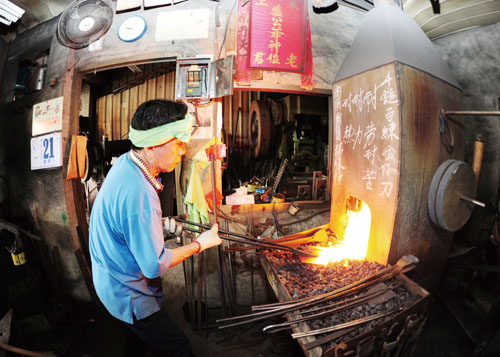 Kuo says the working environment is hot and the work is difficult, so even his own son is not interested in continuing this tradition. Kuo, who loves to study swords and other types of arms, has opened the Kuo Chang-si Arts Swords Museum near his store. In it, he exhibits his own work, as well as swords he has collected over the years. When entering the museum, visitors are immediately immersed in thousands of years of martial art, thanks to the weapons that are on display. These include weapons used during Taiwan's traditional Songjiang Battle Arrays. Thanks to international media coverage, Kuo now receives visits from foreigners wishing to learn sword-making techniques. He hopes that through the museum, he will be able to transmit to other generations the historical and cultural significance of swords.
Kuo says the working environment is hot and the work is difficult, so even his own son is not interested in continuing this tradition. Kuo, who loves to study swords and other types of arms, has opened the Kuo Chang-si Arts Swords Museum near his store. In it, he exhibits his own work, as well as swords he has collected over the years. When entering the museum, visitors are immediately immersed in thousands of years of martial art, thanks to the weapons that are on display. These include weapons used during Taiwan's traditional Songjiang Battle Arrays. Thanks to international media coverage, Kuo now receives visits from foreigners wishing to learn sword-making techniques. He hopes that through the museum, he will be able to transmit to other generations the historical and cultural significance of swords.
淬鍊成鋒 工藝大師郭常喜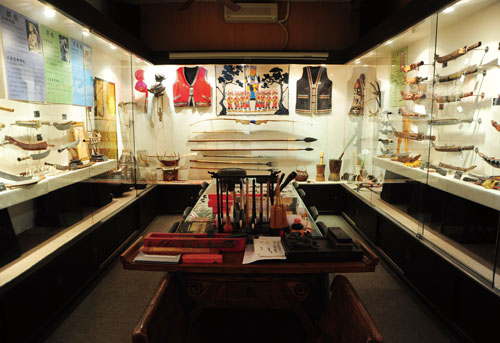
◎文/張嘉玲
◎攝影/鮑忠暉
興達港一帶,一眼望去滿滿漁村風光,國家級工藝師郭常喜所開設的「興達刀鋪」就隱身魚鄉之間。進入黝暗的打鐵間,高溫可達1300度~2000 度的火爐邊,鑄劍師沉默的身影,伴隨火鉗在火爐裡上下撥弄的嗤嗤聲,火星迸飛四濺的場景,不僅映紅了郭常喜的臉龐,也見證了他50年來淬鍊而成,持續自我超越的精湛冶煉技藝。
從13歲起開始向父親學習打鐵技術,鐵匠出身的郭常喜說,打鐵業利潤微薄 ,雖曾一度轉行,最後仍是回到最為熟練的打鐵業。從刀、鋤頭這類日常生活器具作起,憑藉對鑄造的經驗和熱情,30歲之後,郭常喜逐漸轉型,埋頭鑽研刀、劍的製作方法。他研發出「積層摺疊花紋鋼」的製作方法,這項研發也讓他獲得專利認證。郭常喜將印度的大馬士革鋼、日本鑄劍技術、古代的包鋼技術(刀體為鐵,兩側包鋼)融合,重現古代的鑄劍技藝,刀體不僅堅固,並將他的作品帶向藝術等級。許多人為了收藏而向郭常喜購買寶劍,郭常喜笑著說,他目前還是有打造日常使用的菜刀類用具供來客挑選。
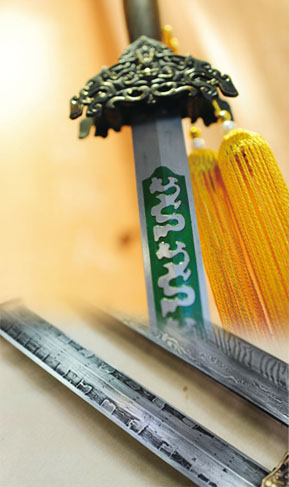 郭常喜表示,「一把劍是藝術品,完成沒有時間表。」一般用以鑄劍的鋼料材質,鑄造後劍身會產生自然的花紋,而以積層鋼打造的劍身則可以「 控紋」技術來設計劍身上所出現的紋路,也是郭常喜將創意發揮至無限大之處,藉由熟練的控紋技術,他考據兵器譜,重現古代名劍「干將」、「莫邪」、「魚腸劍」的獨特劍身花紋。郭常喜表示,民國94年全國第五十九屆美展工藝類的入選對他意義重大 ,欣喜之餘,現今68歲的郭常喜仍不斷地自我砥礪,不斷在材質 、劍身花紋方面研發,打造出更臻完美的作品。
郭常喜表示,「一把劍是藝術品,完成沒有時間表。」一般用以鑄劍的鋼料材質,鑄造後劍身會產生自然的花紋,而以積層鋼打造的劍身則可以「 控紋」技術來設計劍身上所出現的紋路,也是郭常喜將創意發揮至無限大之處,藉由熟練的控紋技術,他考據兵器譜,重現古代名劍「干將」、「莫邪」、「魚腸劍」的獨特劍身花紋。郭常喜表示,民國94年全國第五十九屆美展工藝類的入選對他意義重大 ,欣喜之餘,現今68歲的郭常喜仍不斷地自我砥礪,不斷在材質 、劍身花紋方面研發,打造出更臻完美的作品。
郭常喜說,打鐵環境過於炙熱、辛苦 ,連自己的兒子都不願接手。喜愛研究刀劍兵器的他,在興達刀舖附近設置「 郭常喜兵器藝術文物館」,展示多把由郭常喜自己鑄造或是收藏的刀劍文物。走進文物館,千百年前的「江湖」恍然對遊客招手微笑,各式兵器陳列架上,包括台灣著名的宋江陣兵器。郭常喜的名氣經過國際媒體的報導,連外國人都前來拜師學藝,他希冀能透過兵器藝術文物館,成就他想要將冶鐵、鑄劍相關歷史文化意涵傳承下一代的心願。